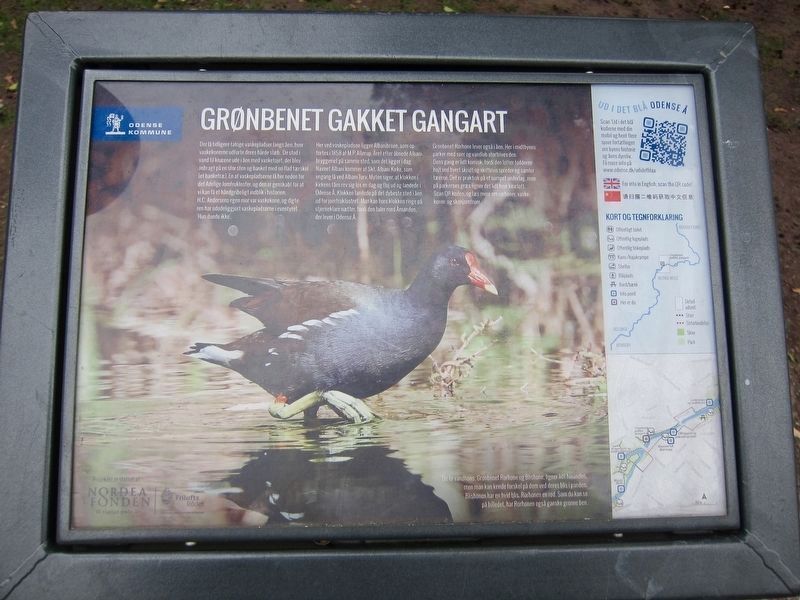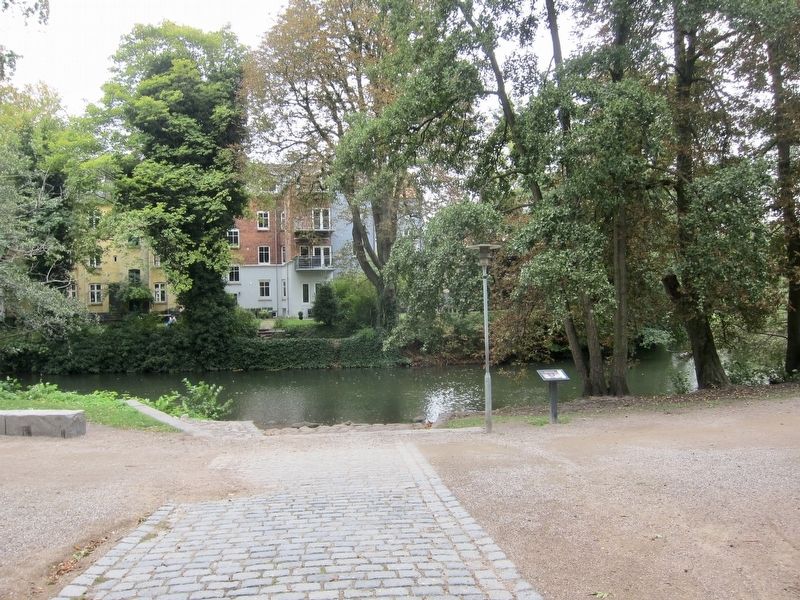Grønbenet Gakket Gangart / Washladies, Water Sprites, and Waddlers
Her ved vaskepladsen ligger Albanibroen, som opfortes i 1858 af M P. Allerup. Året efter åbnede Albanibryggeriet på samme sted, som del ligger i dag. Navnet Albani kommer af Skt. Albani Kirke, som engang lå ved Albani Torv. Myten siger. at klokken i kirkens tårn rev sig los en dag og floj ud og landede i Odense Å. Klokken landede på det dybeste sted i åen ud for jomfruklostret. Man kan hore klokken ringe på sljerneklare nætter, fordi den taler med Åmanden, der lever i Odense Å.
Grønbenet Rorhone lever også i åen. Heri midtbyens parker med søer og vandlob stortrives den. Dens gang er lidt komisk, fordi den lofter fodderne hojt ved hvert skridt og skiftevis
spreder og samler tæerne. Det er praktisk på et sumpet underlag, men på parkernes græs ligner det lidt hoje knæloft. Scan QR koden, og læs mer om rorhoner, vaskekoner og skønjomfruer.-
There were previously numerous washing places along the river, to which the washerwomen carried their heavy load. They stood in the water to their knees midstream stream with their wash, which was placed on a large stone and flattened with a paddle. One of the washing places was down here below the unmarried womens home, and it has been recreated so that we can get a tangible insight into history. H.C. Andersen's own mother was a maid, and the author has immortalized these washing places in the fairy tale, 'She was Good for Nothing'.
Near the washing place here is the Albani Bridge, which was built in 1858 by M. P. Allerup. The following year, the Albani brewery opened in the same place, still going today. The name Albani comes from St. Albani Church, once located on Albani Square. A myth says that the bell in the church's tower flew off one day, landing in the Odense River. The bell landed in the deepest point in the stream next to the home for unmarried women. One dark and scary nights, one can hear the bell ringing, speaking with the water sprites who live in the river.
The Common Mudhen also lives here in the stream. It
Erected by Odense Kommune.
Topics. This historical marker is listed in these topic lists: Animals • Industry & Commerce • Women. A significant historical year for this entry is 1858.
Location. 55° 23.766′ N, 10° 23.558′ E. Marker is in Odense, Syddanmark (Southern Denmark), in Odense Kommune. Touch for map. Marker is in this post office area: Odense, Syddanmark 5000, Denmark. Touch for directions.
Other nearby markers. At least 8 other markers are within walking distance of this marker. Hans Christian Andersen - School (about 120 meters away, measured in a direct line); The Oldest Kingdom of the World (about 150 meters away); Ølbryggeri Og Gelændergaranti / A Beer Brewery and the Guaranteed Railings (about 150 meters away); Kongemord og Tordenskræpper / Royal Murder and Red Butterbur (about 210 meters away); Munke Mølle / Monks' Mill (approx. 0.4 kilometers away); Ambrosius Stub (approx. half a kilometer away); Nonner på Vikingborgen / Nuns at the Viking Fortress
(approx. half a kilometer away); Hans Christian Andersen at Vestergade 57-59 (approx. 0.6 kilometers away). Touch for a list and map of all markers in Odense.
More about this marker. The marker is on the north bank of the Odense River, just east of the Albani Bridge, in the greenbelt that runs along the north side of the river.
Also see . . . She Was Good For Nothing (Andersenstories.org). Text of the Hans Christian Andersen fairytale about a washerwoman and her son. (Submitted on February 27, 2019.)
Credits. This page was last revised on February 27, 2019. It was originally submitted on February 27, 2019, by Andrew Ruppenstein of Lamorinda, California. This page has been viewed 150 times since then and 15 times this year. Photos: 1, 2. submitted on February 27, 2019, by Andrew Ruppenstein of Lamorinda, California.

